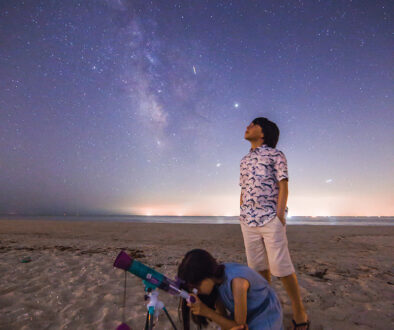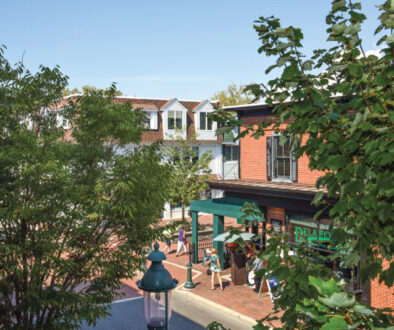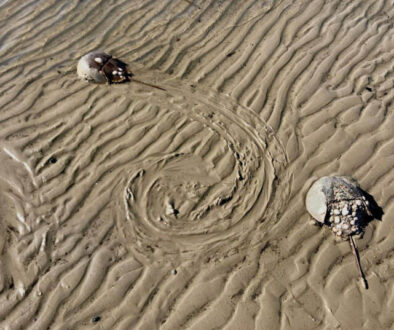The Journey to Freedom’s Journey to Cape May
Despite the celebration of Wesley Wofford’s larger-than-life and utterly moving sculpture of Harriet Tubman in his piece, The Journey to Freedom, currently on loan to the Harriet Tubman Museum in Cape May, it was never intended for public consumption. At least not at first.

A figurative sculptor from North Carolina, Wofford was commissioned to create the Tubman piece for a private client.
“With this one, essentially, it was a client we worked with before and they just reached out to us and said, ‘We’re thinking about doing a Harriet Tubman. We’re thinking maybe Harriet Tubman and a child,’” says Wofford. “And they wanted it to project freedom.”
Wofford, along with his wife and studio director, Odyssey Wofford, began extensive historical research and landed on the story of an eight-year-old girl that Tubman led to freedom and ultimately adopted, and who is often speculated as being Tubman’s own daughter or niece.
The figures, together, loom larger than life at nine feet tall.
“I think that scale very much affects how a user interacts with an object, specifically a sculpture of a person,” says Wesley. “We’re these creatures that are constantly moving around and so when you’re trying to capture that sort of spirit in an object that is still, and is bronze, and so it doesn’t have the luster of skin—it’s metal—I think that scale shift (from life-size to one and a third, or one and a quarter size) helps capture the bigness that we are by the energy we emanate just by being alive.”
The resulting piece is moving and intimate, conveying both fear and bravery. It’s a courageous portrayal of a courageous woman.
“It was probably the most important historical figure that I have done. I mean, I have done portraits for the Nebraska State Capitol and other private commissions, but this was really the first where someone was trusting me with doing an important historical figure,” says Wofford of the 18-month process. “It was a lot of pressure and I’m glad that I sort of pulled it off.”
He did more than pull it off.
“I think that scale very much affects how a user interacts with an object, specifically a sculpture of a person.”
The private piece, which was eventually shared on social media, blew up. It attracted a frenzy of interest as well as the attention of Upworthy, a website for viral content to promote stories on politics and social issues, and Cape May’s own Bob Mullock, who was spearheading the Harriet Tubman Museum project.
“I was going online, looking for Harriet Tubman things, and it just popped up that this sculpture was put together by Wesley Wofford,” says Mullock. “And I thought ‘Wow, this would be so great.’ So, I talked to him and I said, ‘How much would it be if we wanted to buy that?’ and he said, ‘It’s not for sale’.”
The piece—all 2400 pounds of bronze—was already sold, Wofford explained to Mullock, having been privately commissioned. And that, really, could have been the end of the story.
“At that point we had no intention of doing an artist print because that’s a big financial investment in itself,” says Wofford, who was contractually allowed to make his own personal artist copy of the original sculpture—but one that couldn’t be sold.
It was a serendipitous lunch that changed the trajectory of The Journey to Freedom.
“There was so much going on in the world that made that piece connect with people, and people really wanted to see it in person. Luckily, we had a different client that helped fund the casting of the second one. We had lunch with him and his wife and we were telling him about it and he’s like, ‘Well, we should cast one. Let’s cast one and travel it around. What do you think?” says Wofford. “He thought it was very important.”
The Woffords agreed.
“With all the social unrest and the Black Lives Matter movement kind of swelling and people becoming more cognizant of (the notion that) we pretended like this has been fixed, and it’s not, it just really was too serendipitous to not do it,” says Wofford. “It just seemed like the right thing to do.”
While Cape May was originally the sculpture’s first scheduled destination, The Journey to Freedom first traveled to Montgomery, Alabama, and the Equal Justice Initiative, where it was on display for two weeks prior to COVID shutting things down.
“It’s kind of nice because it reminds me of Harriet Tubman coming back out of the Confederate states into a free state. It’s kind of like a ‘they’re escaping again’ kind of thing,” says Mullock of that particular travel route. “I thought it was blessed by being at other museums.”
And though Mullock was happy to be second in line to receive the sculpture, COVID upended things here as well.
“We had targeted our opening date to be Juneteenth 2020, and of course when that came around, we were in the middle of a pandemic,” says Cynthia Mullock, Executive Director of the Harriet Tubman Museum. “But we were also opening a museum that’s dedicated to social justice and racial justice, and here we are on June 19, 2020. George Floyd had just been murdered. The social movement in our country around social justice and racial justice was underway, and we felt for us to be silent…how could we not do something?”

The Museum celebrated a Virtual Opening on Juneteenth 2020, but due to COVID restrictions, very few people got to go inside the museum and see Wofford’s sculpture, or the rest of its thorough collection.
Luckily for Cape May, the Woffords were committed to the idea of The Journey to Freedom having its moment in the Harriet Tubman Museum.
“Now there’s an approximate two-and-a-half year waiting list, but they were so nice, they called and said they were going to give it to us for June, July, August, and September,” says Bob Mullock. “And you just can’t get any better than that.”
For the sculpture’s second visit, Bob Mullock wanted to celebrate its journey with everyone, beginning with a tour through Washington D.C. on a flatbed truck.
However, with all the demonstrating that was happening in the city, he didn’t feel he could ask the driver to do that. Instead, he focused on visiting places that Tubman would have seen in her lifetime right here in Cape May.
“The police were kind enough to give us an escort and we took it to key sites around town, places that existed when she was alive,” says Bob Mullock. “We went to Cape May Point and had it in front of St. Mary Retreat House, which at one time was owned by abolitionists. Then by the lighthouse, which is what a lot of slaves could see from the slave state of Delaware; the Memorial on Columbia Avenue; in front of Congress Hall, The Chalfonte Hotel, AME Church, Franklin Street School, and then here. It kind of brought her alive.”
Shortly thereafter, the Woffords were invited by the Mullocks to attend a cocktail party with the museum donors.
“Everyone could hear him talk about it, and express what the symbolism was,” says Bob Mullock of Wofford. “When he was here, we were extra cautious about touching (the sculpture) and he was like, ‘put your hands right on it.’ It’s a piece to appreciate that way.”
Indeed, it is. In the past year, the sculpture has been displayed at a variety of venues across the country, some of them outdoors. The piece is made to withstand quite a bit. “In general,” says Wofford, “They’re kind of like 15,000-year objects.”
It’s the kind of permanence that has always delighted Wofford.

“I was really inspired when I was young by European sculpture, Hercules, Greek sculpture, and things in history books. I was just fascinated with that. And it’s like, wow, I’d love to contribute to that world dialogue during my life,” says Wofford. “That sort of permanence of objects really appealed to me.”
Though impermanent here in Cape May, The Journey to Freedom leaves an indelible mark.
“I felt like this was something that elevated the museum, to have such a substantial piece,” says Bob Mullock. “They say a picture is worth a thousand words, but to me, a sculpture is worth 10,000 words. Because you can look at it from different sides, you can touch it, and feel it. And this is such a meaningful piece of work.”
Fearless in Fear
The Journey to Freedom isn’t the only magnificent sculpture currently on view at the Harriet Tubman Museum. To the left of that piece, anchoring a corner of the museum, sits Fearless in Fear: A Young Harriet Tubman by Philadelphia Sculptor, Kate Brockman.

The bust was donated by Brockman and is part of the museum’s permanent collection. And in another serendipitous instance, the bust was awarded the Gold Medal & Charlotte Geffken Prize by the National Sculpture Society on Juneteenth, 2021, which was also the official grand opening of the Harriet Tubman Museum.
“And it was the first Juneteenth National Independence Day. We had planned this for two-and-a-half years, and on the same day, June 19, the National Sculpture Society announced that Kate Brockman’s piece was the gold winning sculpture in the country,” says Cynthia Mullock. “It was an embarrassment of riches.”
“It was such an amazing thing,” says Bob Mullock. “You have these two most important sculptures in the country in this small place. It sets a standard.”



